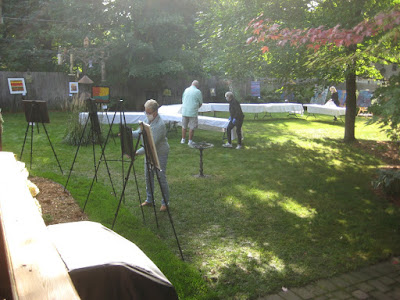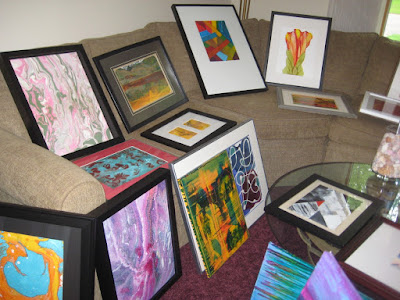Waves
of bohemian creative-type characters, with Kerouac, Ginsburg and Burroughs
leading the charge, had washed over San Francisco a year or two earlier than my
arrival. North Beach coffee houses, cafes and nightclubs were overflowing with
poets, folk singers, jazz players and other disenfranchised elements of the art
world. Alienated youth were beginning to hang out in the Haight-Ashbury
neighborhood and gathering in Golden Gate Park for their music festivals. Across
the bay in Marin County, outlaws and outcasts were being drawn to the ‘action’
in the city.

This
was truly the calm before the storm. The social, sexual, and cultural changes
that defined the 1960s were all taking shape in cities like San Francisco, New
York, London and around the world. A younger generation was beginning to stir
and awake to the injustices it found all around it. There was a new sense of
sexual freedom with the pill. Rebellious youth, fueled by rock and roll music and
marihuana, were speaking and acting out. Linear thoughts gone aground by poets
and philosophers up in North Beach and Greenwich Village were opening up young
minds to new thoughts and aspirations.
All
of this was happening as I arrived at the Presidio of San Francisco in the
early summer of 1964. I had left college and the proverbial ‘girl back home’
for my first true adventure courtesy of my Uncle Sam.
The
greater Bay Area was slowly coming alive with more commercial development.
Marin County was seeing growth up along the north coast and among the bays and
inlets of the bay. Sausalito was still a backwater village but feeling the
growing pressure of a city expanding beyond its past one hundred year borders.
My
work as a reporter/writer at the Command Post newspaper was fulfilling,
enlightening and eye opening, all at the same time. Fortunately, my boss was a
lifer who loved the military and his job. He made it easy for me to come to
work every day. In addition, there was the usual cast of characters who in
retrospect could fill a dozen or more plays and novels with high drama,
suspense, dalliances, corruption, and colorful behavior.
There
were several off-post separation parties that became legendary for their
gratuitous, outrageous behavior, heavy drinking, and sordid but funny
happenings. My only excuse is youth, immaturity and pent-up hormonal demands.
In reality, I was just an observer, too inexperienced to get involved, but
smart enough not to envy those who did.
My
time spent in San Francisco was a wonderful gift I didn’t appreciate until long
after it was gone. It marked the beginning of my long-winded running career and
journaling, my prelude to future novels, plays and screenplays. It was like
some wonderful party that can’t be replicated afterwards even if all the same
participants gathered together once again.
A
journey is really a time capsule. It’s a sliver of space in one’s life that
gives birth to either good memories or bad, to wonderful thoughts or sad
reflections. Yet it always remains locked in that serendipitous turn of events
which can never be replicated or replaced. Whatever happened did happen.
Whatever was gained can’t be changed even if it later becomes lost in a fog of
future events. That’s how my tour of the California North Country was born.
The
idea for a road trip was hatched early one Sunday morning in some unnamed dive
bar on North Beach. We were a motley assortment of drugstore cowboys, fast food
aficionados and one kid with two years of college under his belt. Each of us
ruminating on about our pending release from military service a monumental two
years away. This was long before “Easy Rider” and my own sojourn to Denmark.
What
were we going to do after the service? Return to college. Head out for Europe.
Stay in San Francisco or hit the road just as Jack Kerouac did in “On the
Road.”
The
more sober philosophers among us thought we should get on with our lives. We
should go back home after our hitch was up, get an education, marry our college
sweetheart and settle down to the good old standard American life. The more
inebriated among us thought otherwise. Another round of beers and an impromptu
survey was taken. The open road garnered first place with Europe a close
second. Returning home to suburban tranquility didn’t even register.
Some
of us were already open road desperados. One guy had a big-ass Triumph 650cc
motor-cycle with enough horsepower to fly between San Francisco to Los Angeles
in record time. He went down to the city of angels almost every weekend to see
his girlfriend. That is until a transfer landed him in the middle of nowhere
Indiana in a snowstorm and his bike went into cold storage.
A
couple of guys had souped-up cars they’d brought to the Presidio from back
home. But soon one fellow was shipped off to Vietnam and another got
transferred to Okinawa. Several more wantabees disappeared when sobriety raised
its ugly head. So that effectively took most of my gang out of the picture. I
was the only one left with my Vespa motor scooter and exaggerated, romantic
notions of the open road still spinning around in my head.
A
dream had been ignited in my plastic brain that resonated throughout my body. I
decided I might as well hit the asphalt right then and there instead of waiting
another two years before my enlistment was up. My destination would be the
distant lands north of the Golden Gate Bridge. At that point, they had just
been shadowy mounds of gray that kissed the skyline outside my office window.
This
was the old Northern California countryside before multiple ballot propositions
changed the political and social landscape and a bulging San Francisco disgorged
its inhabitants far and wide; spilling them out across the bay to once tiny
hamlets like Sausalito, Mount Tamaulipas, and Stinson Beach. It was a time when
cows roamed empty fields amid gun emplacements that still protected San
Francisco bay from Japanese battleships. An era, before satellites, when radar
stations scanned the northern skies for raiders from Russia. A time when only a
few small enclaves of new housing slashed into the green hillsides. A time when
the only sound heard was the putt-putt of my tiny Italian engine against a wind
blowing oceanside and birds on high, floating silently in the sea breeze.

After
I had braved the crazy traffic on the bridge, I swung north to the tiny enclave
of Sausalito. Even back then Sausalito was a very special place. During the
war, the Navy had installed a host of ship maintenance facilities. By the
sixties those had all disappeared but a lot of the ship workers had stayed.
They were joined by displaced beats and hippies from across the bay.
Together
they made Sausalito an eclectic community, a growing artist colony and home to
the funky and weird. On the way out of town, I spotted this inlet where fancy
cars were parked in front and yachts in back. It was a novel idea at the time,
priceless in this day and age. It was the first sign of encroaching humanity.
The pristine countryside of Sausalito was becoming just another suburb of San
Francisco.
This
was one of dozens of inlets along the coast road where the sea had dumped its
collection of driftwood and debris on land. I’m sure there were treasures down
there but I never stopped to investigate. I was so tempted to ride down to this
house to see who lived there. I can’t image a more remote, mysterious and
wonderful place to live. It was probably some writer toiling on the great
American novel and suffering the pangs of a broken love affair.
Back
along the bay, I came across this new military housing complex being built. The
view out their front door was to die for.
But more fascinating were the old World War Two defensive installations that
ran up and down the bayside. It was a concrete collection of pillboxes, command
centers and the foundations for large cannons which would have been pointed out
to sea. Then behind those old
fortifications was a new radar facility and cameras pointed down at a kid on a
scooter who was peering up at them.
By
the end of the week, I was flying with wild abandon. Yet I only crashed once,
taking a curve too fast on wet leaves and ending up in a gully sans my glasses,
hat and pride. The scooter was OK except for the mud and leaves that coated its
undercarriage with brown muck. I found
my glasses, picked the dirt out of my teeth, and climbed back up on the saddle
again.
During
that week, one song in particular kept bouncing around inside my head. “Four
Strong Winds” by Ian and Sylvia. It spoke of loss, separation and the
infinitesimal yearning for some-thing better even if ‘it’ couldn’t be defined
at the time. It’s a great song and still brings back a lot of fond memories.
I
realize now that back then I was living in the moment…what Buddhists call
mindfulness. It was just a few short months before that tsunami of change hit
the shores of San Francisco and I was transferred to the hell that was known as
Fort Polk, Louisiana.
Today
we would translate that mindset as conscious living. In his book “Wherever You
Go There You Are – mindfulness meditation in everyday life,” author Jon
Kabat-Zinn talks about mindfulness as enlightening and liberating work. “It is
enlightening in that it literally allows us to see more clearly, and therefore
come to understand more deeply, areas in our lives that we were out of touch
with or unwilling to look at.” Words to build a life on.
I
should ride a scooter more often.


















































